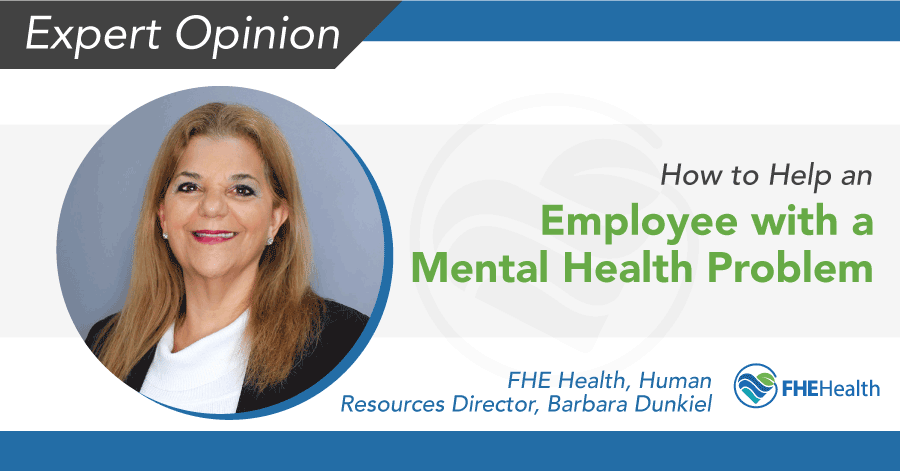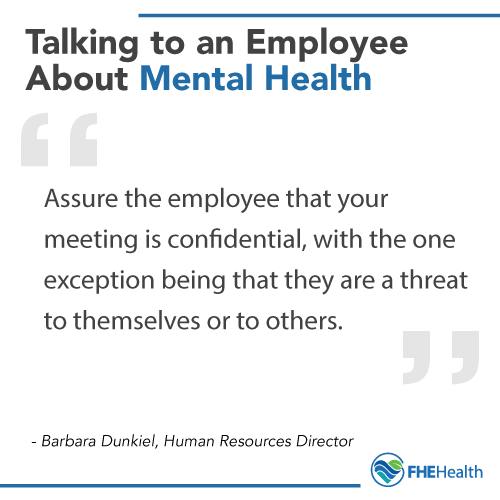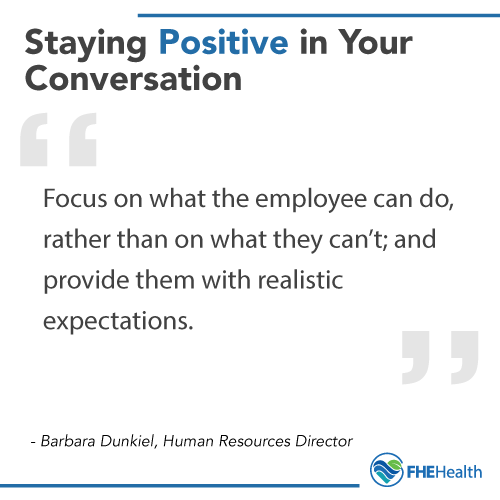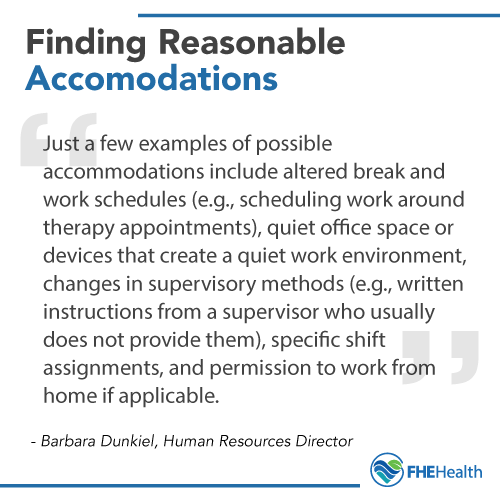
This article has been reviewed for accuracy by our peer review team which includes clinicians and medical professionals. Learn more about our peer review process.
Whether you’re a manager or colleague, your prospects of encountering an employee with a mental health problem may be higher than you think, on the basis of statistics like these from the National Alliance on Mental Illness (NAMI):
- One in five Americans experiences a mental illness in any given year.
- One in 25 Americans experiences a serious mental illness that substantially interferes with one or more major life activities such as work.
Add to that the reality that, by the estimate of the National Safety Council, three-quarters of people who struggle with substance abuse are employed. In a great many of these cases, substance abuse is an effort to self-medicate an underlying mental health condition, for which there is effective treatment.
Mental Health in the Workplace – Common Questions
Mental health issues can therefore be prevalent in the workplace, making it imperative that managers, supervisors and even colleagues have at the very least some basic knowledge about how to help an employee with a mood disorder or another mental health condition such as a substance use disorder.
Some of the more common questions that employers and others in the workplace ask:
- If you suspect a colleague has a mental health problem, how do you intervene and when?
- What measures can you take to encourage an employee to get help?
- What employee resources and laws should be kept in mind?
- Can you fire an employee because of a mental health condition?
We put these questions before Barbara Dunkiel, who as Director of Human Resources is FHE Health’s resident expert on the subject. What follow are her insights on the question of how to help an employee with a mental health problem, as well as her answers to the above questions.
When to Intervene – Employee Performance Issues, Lost Productivity and Other Signs of a Potential Mental Health Problem
If you suspect that an employee has a mental health and/or substance abuse problem, the first question should be not if but when to intervene. One of the clearest indications that it’s time to intervene will be problems with on-the-job performance. These will only become costlier if left unattended. For example, findings by the Centers for Disease Control (CDC) have suggested just how costly: they revealed that depression alone leads to around 200 million lost workdays in the U.S., at a price tag of between $17 billion and $44 billion in lost productivity.
Dunkiel cited the following signs that an employee is not performing at work and may need help for a mental health problem:
- Not reporting to work or excessive unscheduled tardiness
- Leaving work area for extended period of time throughout the day
- Changes in behavior or mood.
- Changes in how they are interacting with co-workers
- Changes in job performance, motivation levels and ability to focus or make decisions
- Appearing tired, anxious or withdrawn
- Poor hygiene
Any of the above signs could indicate that an employee is experiencing a mental health problem, in which case Dunkiel advised that “the first thing [to do] is to discuss the issue right away with Human Resources to seek guidance.” She reiterated, “Don’t do anything without consulting HR,” the reason being that “a lot of different things and decisions need to be addressed, such as employee rights under protection of certain laws and company policies and procedures.”
Talking with an Employee About a Mental Health Problem
 The task of talking with an employee about a mental health problem should be discussed between HR and the employee’s direct supervisor. (If a colleague first notices the problem, reporting the issue to their supervisor and/or HR can be the extent of their involvement.) For companies that do not have an HR department, Dunkiel recommends that the supervisor follow these steps for approaching the conversation:
The task of talking with an employee about a mental health problem should be discussed between HR and the employee’s direct supervisor. (If a colleague first notices the problem, reporting the issue to their supervisor and/or HR can be the extent of their involvement.) For companies that do not have an HR department, Dunkiel recommends that the supervisor follow these steps for approaching the conversation:
- Address the concern immediately.
- Meet with the employee in private, in a quiet space where the person feels comfortable.
- Be honest and describe the specific changes/behaviors you have witnessed.
- Engage them in conversation.
- Actively listen, show empathy, and ask simple open and non-judgmental questions.
- Try to keep the focus on the job performance issues that you’re noticing.
- If, like FHE Health, your employer has an employee assistance program (EAP), one recommendation is to strongly suggest they call the EAP for help. If your employer does not have an EAP, refer them to resources in your area such as a trusted mental health treatment program.
- Assure the employee that your meeting is confidential, with the one exception being that they are a threat to themselves or to others.
- Reassure them. Tell them your door is always open if they have any issues, problems or concerns.
- Remember this is an “interactive process,” meaning the employer and the employee should work together to discuss the possibility of making reasonable accommodations if needed. (Read on to learn more about the types of accommodations that can be made for mental health disorders.)
- Discuss some of the options that may available to the employee, such as Family Medical Leave or Personal Leave, as well as medical workplace accommodations.
- Meet with the employee to follow up. This step should only occur after the employee has had sufficient time to get help, pursue medical treatment and discuss if further workplace accommodations are necessary. Additionally, if poor job performance was an issue, this meeting will be an opportunity to discuss whether the employee’s performance has improved or further actions need to be taken.
How Support Someone with a Mental Health Problem
 In addition to the above measures, Dunkiel said there are other ways you can show support for a co-worker or employee with a mental health problem. “Be positive,” she said. “Focus on what the employee can do, rather than on what they can’t; and provide them with realistic expectations.” Dunkiel advocated working together with the employee and Human Resources to find solutions, action plans, and policies and processes that can accommodate the employee’s mental health condition.
In addition to the above measures, Dunkiel said there are other ways you can show support for a co-worker or employee with a mental health problem. “Be positive,” she said. “Focus on what the employee can do, rather than on what they can’t; and provide them with realistic expectations.” Dunkiel advocated working together with the employee and Human Resources to find solutions, action plans, and policies and processes that can accommodate the employee’s mental health condition.
Describing her approach at FHE Health, Dunkiel said, “Any time there’s a request for a medical accommodation, we meet with the employee via an interactive process and discuss what needs to be done. Do they need time off? Help from EAP? Work modifications? If the mental health issue is an anxiety disorder, we may try to relieve the employee of some of their responsibilities.”
Reasonable Accommodations for Mental Health Disorders
In these conversations, the posture of HR and the employee’s supervisor should be compassionate and solution-oriented, with a goal to working collaboratively with the employee to develop accommodations that will help that employee fulfill their job duties.
“A reasonable accommodation is some type of change in the way things are normally done at work,” Dunkiel explained. “Just a few examples of possible accommodations include altered break and work schedules (e.g., scheduling work around therapy appointments), quiet office space or devices that create a quiet work environment, changes in supervisory methods (e.g., written instructions from a supervisor who usually does not provide them), specific shift assignments, and permission to work from home if applicable.”
(This list from the Department of Labor gives still more examples of the types of accommodations that can be made for employees with psychiatric disabilities.)
Mental Disorders and the Americans with Disabilities Act (ADA)
 Employees with mental health conditions have the Americans with Disabilities Act (ADA) to thank for the fact that they can now receive workplace accommodations in the same way that employees with physical health issues can. The ADA gives federal protections to people with mental and physical disabilities or “impairments.”
Employees with mental health conditions have the Americans with Disabilities Act (ADA) to thank for the fact that they can now receive workplace accommodations in the same way that employees with physical health issues can. The ADA gives federal protections to people with mental and physical disabilities or “impairments.”
Under the ADA, Dunkiel said, “an interactive process takes place between employer and employee to determine what and if an accommodation can be made without causing an undue hardship.” She noted that “mental health will be treated in the same way as a physical disability under The Americans with Disabilities Act (ADA), which protects the employee from discrimination or harassment. This includes firing, rejecting a person for a job or promotion, or forcing an employee to leave.”
According to Dunkiel, the ADA defines mental impairment as any mental or psychological disorder which “substantially limits” the person’s ability to concentrate, interact with others, communicate, eat, sleep, care for oneself, regulate thoughts or emotions, or do any other “major life activity.” Primary mental health disorders are major depression, bipolar disorder, anxiety disorders (which includes panic disorder, obsessive compulsive disorder (OCD) and post-traumatic stress disorder (PTSD)), or another mental health condition.
Can an Employer Fire an Employee Because of a Mental Health Condition?
“No,” Dunkiel said. “However, an employer doesn’t have to hire or keep people in jobs they can’t perform, or employ people who pose a ‘direct threat’ to safety (a significant risk of substantial harm to self or others).” She added that an employer cannot rely on myths or stereotypes about your mental health condition when deciding whether an individual can perform a job or whether they pose a safety risk.
What if an Employer Can’t Make a Reasonable Accommodation?
Dunkiel acknowledged that there can be those gray areas where an employer isn’t able to make a reasonable accommodation for an employee with a mental health condition. In those cases, and if an employee “can’t perform all the essential functions of their job to normal standards and have no paid leave available,” Dunkiel said “they may still qualify for unpaid leave as a reasonable accommodation, if that leave will help get them to a point where they can perform those functions.” Here she referenced the “Family and Medical Leave Act” as a helpful resource for anyone considering an unpaid leave of absence for a serious health issue (like a mental health condition).
There will also be those times when a person with a mental health condition is permanently unable to fulfill their regular job. In these cases, one way that employers can help is to “suggest a transfer to another position or status change in which a reasonable accommodation can be made to better meet the needs of the employee and employer, if possible.”
What Employers Can Do to Educate Managers and Employees on Mental Health?
Employers can help employees with mental health problems by taking preventative measures as well. Dunkiel recommended the following:
- Provide training on recognizing signs and symptoms of mental health.
- Provide new employee orientation which addresses FMLA, ADA, Harassment and EAP benefits.
- Promote wellness programs.
- Encourage employees to make use of the EAP program to reduce stigma.






